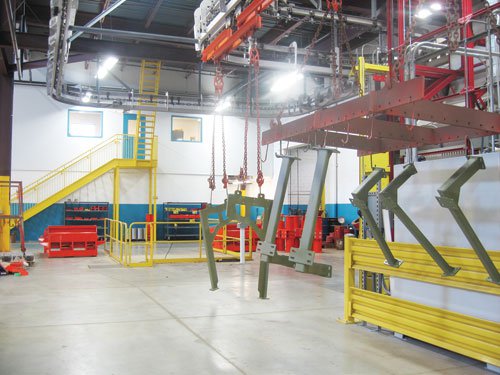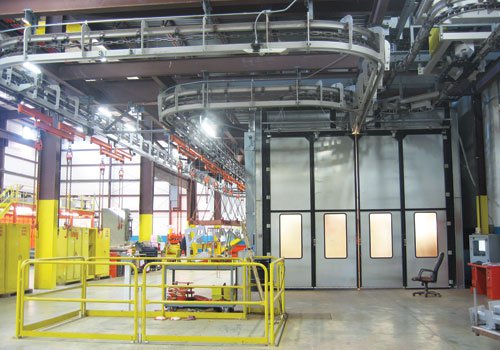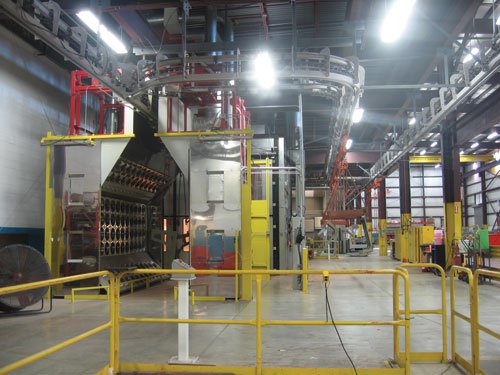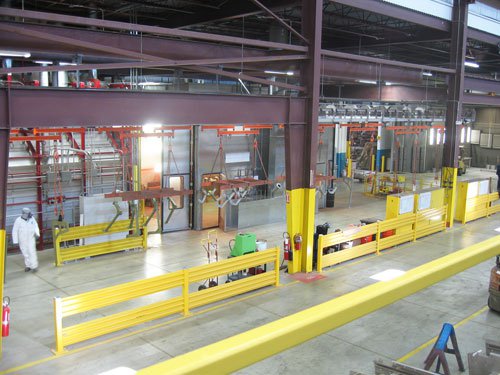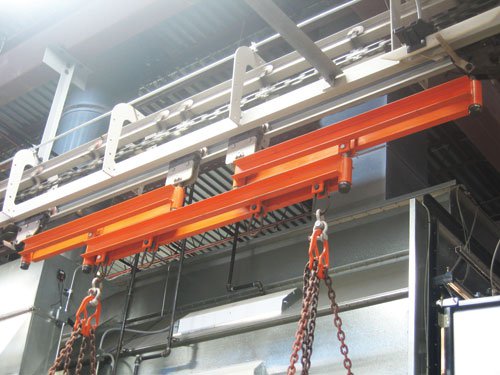Overhead, Power and Free Monorail Conveyor System
Sweco Looks Up for Answers to Improving its Painting Operation
Sweco, a leading manufacturer of industrial particle separation equipment, wanted to streamline its parts painting operation. The process includes blasting with steel shot the many parts and components that go into the assembly of the company’s equipment, then painting, and properly drying the parts after the primer or paint is applied. Sweco designs, manufactures and assembles most major components for its line of separation and particle size reduction equipment at its Florence, KY headquarters.
Prior to adding 30,000 square feet to its manufacturing facility, the painting operation was in an area of the plant where ceilings height ranged from 16 to 18 feet. The relatively low ceilings restricted the use of overhead lifting equipment. When parts and components were ready to be painted, they were brought into a blasting booth with forklifts. Small parts were hung from the ceiling on chains, while larger and heavier parts were placed on saw horses. Once blasted, the parts were moved out of the blasting booth with forklifts and staged for painting.
The same manual method was then repeated to move the parts into the company’s 11 foot tall paint booth. Sweco would put as many parts as possible into the booth at one time, again either suspended on chains, or sitting on saw horses. Each batch of parts required three coats of paint, and roughly two hours of air drying time in between each coat. While parts were drying, they sat inside the paint booth, meaning no additional painting was taking place. When the time-consuming process was complete, the parts were removed from the booth with a forklift and taken to the assembly area.
When demand for parts - painted and ready for assembly - outstripped the department’s ability to deliver, Sweco outsourced the painting function to local paint shops. The system worked, but not as efficiently at the company would like.
30,000 Square Feet, with Plenty of Ceiling Height
In late 2007, Sweco began laying out plans for a plant expansion to more efficiently handle growing demand for its vibratory separation equipment. Sweco’s Manufacturing Engineering Team saw an opportunity to move the painting operation to the new building and take advantage of ample overhead space.
With general mechanical contracting and consulting help from Young and Bertke, Cincinnati, OH, the Sweco project management team worked with TKF, Inc., a Cincinnati based material handling company and distributor for the Jervis B. Webb Company. TKF conceptualizes designs, builds and installs conveyor systems including vertical lifts, accumulation conveyor, and overhead conveyor systems.
TKF’s challenge was to reduce the start-to-finish time needed to paint a part; automate, yet allow manual control of the flow of parts through the system; and increase the department’s output capacity. They approached the painting function from a pure material handling point of view, conceptualized, and designed a system that included an Overhead, Power and Free monorail conveyor system that would streamline the flow of the wide variety of parts Sweco manufactures, into and out of the painting process.
A totally integrated overhead crane, lift platforms, and TKF’s overhead, power and free monorail conveyor were installed in the new facility in mid-2008. The overhead crane was positioned between the new blasting booth Sweco installed and the lift platform, with the lift platform located at the loading end of the overhead monorail conveyor. Also installed were a new paint booth, and infrared curing oven that would allow Sweco to take full advantage of the new monorail conveyor.
Since Sweco was doing building design at the same time the new material handling system was being designed, they were able to incorporate the entire overhead crane and monorail into the building’s support structure. No additional support beams were needed inside the building to accommodate the new painting process.
Smooth, Trouble-Free Operation
Fully operational since September, 2008, the painting process begins as parts are transported to the blasting booth. Heavier parts are moved into the booth with the help of the overhead crane, while smaller, lighter parts are transported with a forklift. Once blasted, and ready for painting, they’re moved via the crane or forklift to the lifting platform located just in front of the paint booth. Here they’re lifted and placed on a new Power & Free Carrier system that hangs from the monorail.
Eight custom carriers, each with a 4000 lb. capacity, were designed to hang from the monorail, hold and transport the wide variety of parts Sweco manufactures. Parts currently range in size from 1 foot to 9 feet in length, and up to 2000 lbs. each.
Once parts are suspended from the carrier and ready for painting, an operator uses a simple control panel to initiate carrier movement into the paint booth. The paint booth doors open, and the low-maintenance monorail conveyor transports the carriers into the new paint booth, where they stop. The booth doors close and the parts are then manually spray painted. Manual painting of the parts is most appropriate for Sweco due to the variety of primer and paint schemes the company applies.
With parts suspended, and now moving into and out of the center of the booth on the monorail, Sweco’s painter is much more efficient since he’s able to stay in a compact painting envelop near center of the booth. With little movement, he can paint all sides of the suspended parts before another carrier is moved into place. There’s better lighting, better ventilation, and significantly less paint is used due to efficiencies of the process. Previously, a 50 foot paint hose was pulled through the booth as needed to paint parts that occupied all available floor space in the booth.
When the painting is completed, the booth doors are opened by the operator and the carrier is released to move the parts into an infrared curing oven. The monorail conveyor is installed above, out of heating zone of the oven and is not affected by the heat. Only the carrier and parts enter the oven.
Instead of taking two hours to air dry, the parts are now dried in a single 20 minute cycle. This not only reduces drying time, but improves the quality of the paint job itself. When the curing is complete, the doors on the oven automatically open. After push button actuation, the carrier is released and moves into a staging area.
Since most parts must go through the paint booth three times, the carriers may be looped back to the paint booth, or directed to an unload lift platform. The system operator controls the destination of each carrier. After unload, empty carriers accumulate on a separate line, ready to be returned to the load station.
Both the paint booth and the curing oven were built so that a forklift can drive into them to transport a part directly. This is especially useful when Sweco is working on a heavier, rush or custom part that needs special attention.
Now it Works for Us
According to one of Sweco’s manufacturing engineers, Corey Fry: “The new system has helped us accomplish our time reduction objectives. The two hours it took in between coats of paint, to let each coat dry, and the operator downtime that went along with it has been eliminated. That’s six total hours per batch of parts that we have back now. We also doubled our total output capacity, and eliminated the need to outsource painting.”
Mr. Fry went on to say, “We can put rush parts into the system and get them out very quickly now. We used to have to work around our painting system. Now it works for us. TKF has been great to work with. They very quickly determined the configuration of the system we needed, and designed it to fit within the footprint we had for the operation. We’ve been very pleased.”
Welcome to the TKF News Section!
Here you will find additional information regarding our conveyor systems along with Tradeshow appearances!
Please feel free to explore the links below to see what we've been up to!
